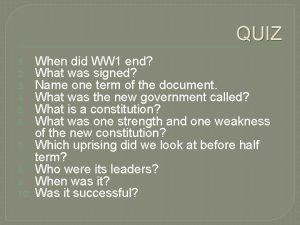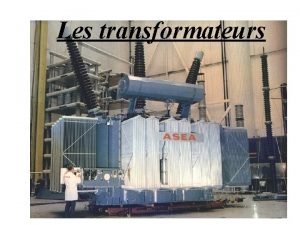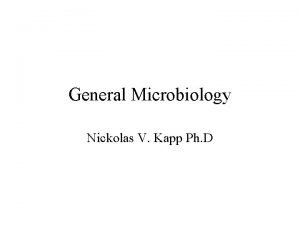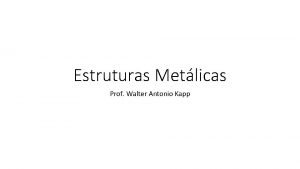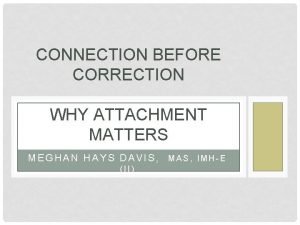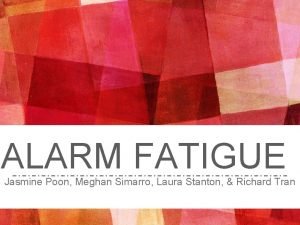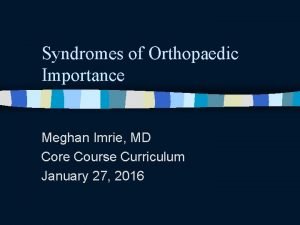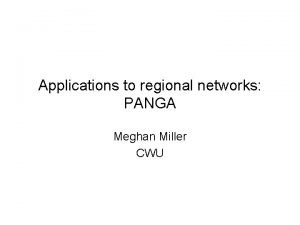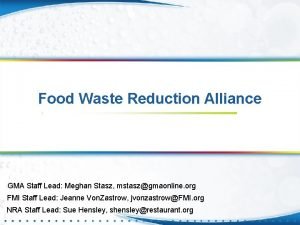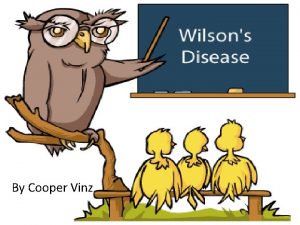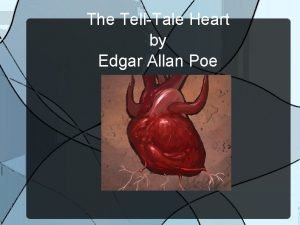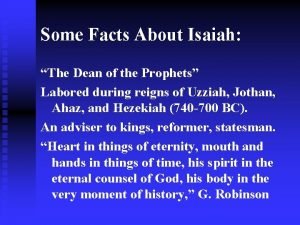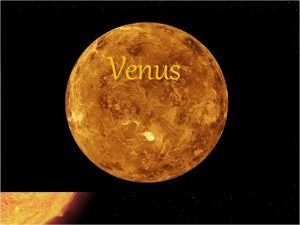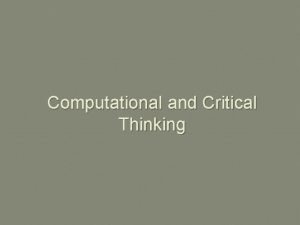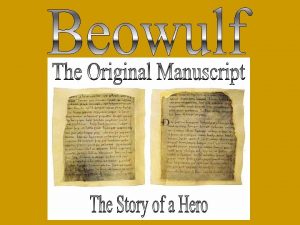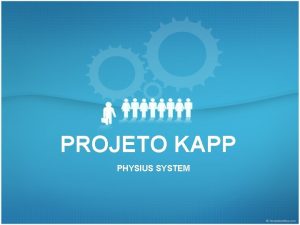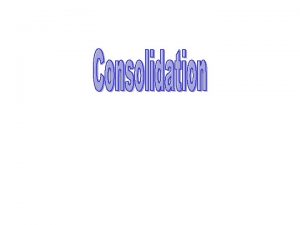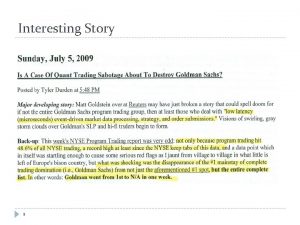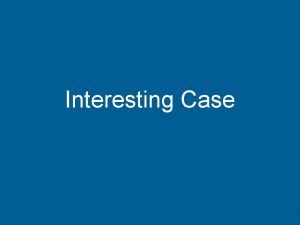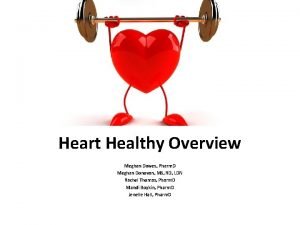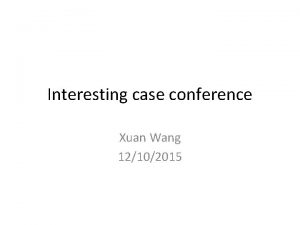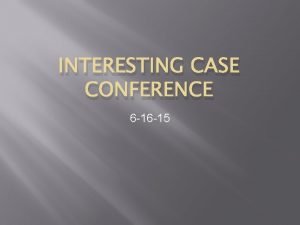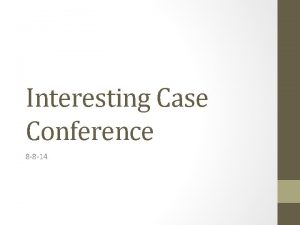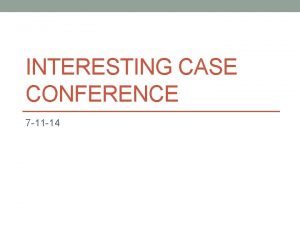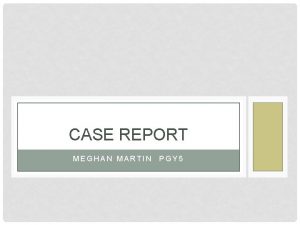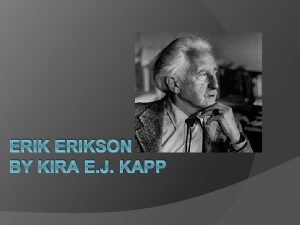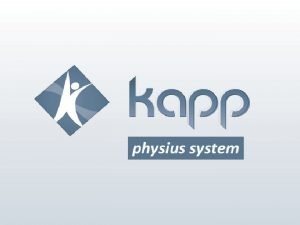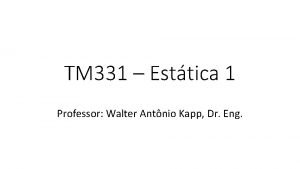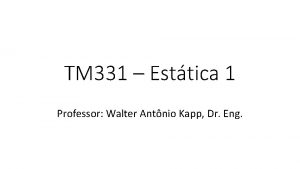Interesting Case Conference Meghan E Kapp MD MS




































- Slides: 36

Interesting Case Conference Meghan E. Kapp, MD, MS 30 March 2015

034901744 POST-TRANSPLANT HEMOLYTIC ANEMIA

Post-transplant AIHA • 8/29/2012 • 26 yo male – Fatigue and shortness of breath – Pancytopenia with blasts on peripheral smear – Family elects to go to Chicago for further evaluation and treatment

Post-transplant AIHA • Status post MRD SCT - Day 0: 11/1/2012 – Donor : sister – 6/25/2013: acute GVHD and neutropenic fever – 8/6/2013: on prednisone, budesonide, prograf, AC 220 – 8/12/2013: 100% donor

AC 220 • Quizartinib – Small molecule receptor tyrosine kinase inhibitor – Ambit Biosciences – AML with FLT 3+

Post-transplant AIHA • 2/2014 Chicago – Hgb 8. 0 diagnosed with hemolytic anemia • p. RBC transfusion • BMBx with no evidence of disease • Bactrim stopped • Rituxin and IVIg • Tacrolimus and Steroids

Post-transplant AIHA • 4/2/2014

Post-transplant AIHA • 6/2014: Hemolytic anemia resolved • 12/2014: Began ECP to decrease tacrolimus • 2/16/2015: During ECP, requested DAT due to shortness of breath and fatigue

Post-transplant AIHA 2/16/2015

Post-transplant AIHA • After allogeneic HSCT, autoimmunity specifically refers to allogeneic lymphocytes that target donor-derived tissue

Post-transplant AIHA • Autoimmune hemolytic anemia is the most frequently reported hematologic complication – 2%-6% and up to 15%-20% • (general population incidence: 0. 0008%; prevalence: 0. 17%) – 5 -12 months after HSCT – Mediated by cold (Ig. M) or warm (Ig. G) antibodies

Post-transplant AIHA • Development has been associated with HSCT from: – Unrelated donors and concurrent chronic GVHD • Suggesting a role for mismatched antigens – Lymphocyte depletion of donor graft with ex vivo lymphodepletion or in vivo lymphodepletion using antithymocyte globulin (ATG) • Removal of CD 4+ CD 25+ regulatory T cells favoring expansion of autoreactive lymphocytes – Being younger at transplantation – Receiving HSCT from peripheral blood stem cells – Short interval from diagnosis of disease to HSCT treatment

Post-transplant AIHA • Treatment and prognosis are not well defined. – Corticosteroids – IVIG – Splenectomy – DLI – Plasma exchange – Erythropoietin – Rituximab – Other immunosuppressing agents

Post-transplant AIHA • Bortezomib • dipeptide boronate proteasome inhibitor • reversibly inhibits the 26 S proteasome function and leads to the accumulation of polyubiquitinated proteins, inducing the death of both short and longlived plasma cells by activation of the terminal unfolded protein response • FDA approved for MM and MCL • Hemolytic anemia related to cryo, SLE, and myasthenia gravis • GVHD prophylaxis

Post-transplant AIHA • Case of successful treatment of immune hemolytic anemia after allogeneic HSCT that was resistant to steroids and rituximab. • ABO major-mismatched • HLA-matched • Unrelated donor • High anti-donor A type antibodies • Bortezomib eliminated residual host-type plasma cells secreting anti-A and restored normal donor-derived erythropoiesis

• Hosoba S, et al. Successful treatment of severe immune hemolytic anemia after allogeneic stem cell transplantation with bortezomib: report of a case and review of literature. Transfusion. 2015; 55: 359 -264. • Sanz J, et al. Autoimmune hemolytic anemia following allogeneic hematopoietic stem cell transplantation n adult patients. Bone Marrow Transplantation. 2007; 39: 555 -561. • Wang M, et al. Autoimmune hemolytic anemia after allogeneic hematopoietic stem cell transplantation: analysis of 533 adult patients who underwent transplantation at King’s College Hospital. Biol Blood Marrow Transplant. 2015 Jan; 21(1): 60 -66.

034636209 THROMBOSIS ON ANTICOAGULATION

Thombosis on Anticoagulation • 54 year old male – History of DLBCL – Status post RIC MRD PBSCT (3/5/13) – GVHD – Arixtra (fondaparinux/factor Xa inhibitor)

Thombosis on Anticoagulation • 2/20/14 – R leg pain and swelling calf to thigh • US – Occlusive thrombus in the femoral to popliteal veins – Cough and shortness of breath • CT – Moderate-sized bilateral pulmonary emboli – Saddle pulmonary embolism moderate to large in size – Started on lovenox (20 th) and coumadin (21 st)

Thombosis on Anticoagulation • 5/8/2014 – Reports switch from coumadin to xarelto (out of meds for two days)

Thombosis on Anticoagulation • 7/11/2014 – US • DVT extending from proximal to mid portion of superficial femoral vein

Thombosis on Anticoagulation • 12/19/2014 – New vs Persistent RLE DVT on Xarelto – Switched to arixtra

Thombosis on Anticoagulation • 12/23/2014 – First day of ECP for chronic GVHD

Thombosis on Anticoagulation • 3/10/2015 – ECP #15 – Extensive clot in his right peripheral access designed to be the return line, but had to be pulled

Thombosis on Anticoagulation • 3/10/2015 – ECP #15 – Extensive clot in his right peripheral access designed to be the return line, but had to be pulled – SCT team: “tends to bleed but interestingly clots through ECP”

Thombosis on Anticoagulation • SCT recipients have high incidence of DVT – Underlying malignancy – Conditioning regimen – Immobility during hospitalization – Universal use of central lines

Thombosis on Anticoagulation • SCT recipients have high incidence of DVT – decrease in circulating natural anticoagulants • Protein C • Protein S • AT – Increase in fibrinogen

Thombosis on Anticoagulation • SCT recipients have high incidence of DVT – Chronic GVHD – Steroid use – APA – FV Leiden

• Ozdemir E, et al. Deep vein thrombosis following nonmyeloablative allogeneic stem cell transplantation: presentation of three x=cases and literature review. Turk J Haematol. 2013. Jun; 30(2): 180 -190. • Pihusch R, et al. Hemostatic complications in bone marrow transplantation: a retrospective analysis of 447 patients. Transplantation. 2002. Nov; 74(9): 13031309.

038106993 WRONG BLOOD IN TUBE?

Wrong blood in tube? • 11/4/2014 • 23 year old female – 4190 gram female – 37 6/7 weeks EGA – urgent c-section • fetal tachycardia and chorioamnionitis – Pregnancy complicated by • Poorly controlled type 1 DM • Complex congenital heart defect – Double inlet left ventricle

Wrong blood in tube? • 11/4/2014 • Maternal – ABO: B – Rh: positive – Antibody screen: not current • Neonatal type & screen: cord blood – ABO: B – Rh: positive – Antibody screen: negative – DAT: Negative for Ig. G

Wrong blood in tube? • Doing well at home with exception of some cyanotic episodes • 3/12: cardiac cath – Near arrest event with transient heart block – Bradycardia and hypotension

Wrong blood in tube? • 3/12 12: 27 Type & Screen – Venous sample – ABO discrepancy • 3/12 15: 20 Type & Screen – Venous sample – ABO: AB – Rh: positive – Antibody screen: negative

Wrong blood in tube? • 3/13: Bidirectional Glenn with PA banding and atrial septostomy – p. RBCs, FFP and cellsaver • 2 units O pos RBC • Plasma AB pos • Apheresis platelets AB neg

Wrong blood in tube? Maternal Neonate 11/4/2014 3/13/2015 ABO B B AB Rh Positive 0 4+ 4+ 4+ Wrong blood in tube? Delayed expression? Laboratory Anti-A?
 Interesting more interesting the most interesting
Interesting more interesting the most interesting Wolfang kapp
Wolfang kapp Diagramme de kapp
Diagramme de kapp Kuwait authority for partnership projects
Kuwait authority for partnership projects Nick kapp
Nick kapp Antonio kapp
Antonio kapp Mn dream act application
Mn dream act application Connection before correction
Connection before correction Meghan poon
Meghan poon Meghan vogel
Meghan vogel Beckwith wiedemann syndrome
Beckwith wiedemann syndrome Meghan troup dalhousie
Meghan troup dalhousie Meghan anzelc
Meghan anzelc Meghan biernacki
Meghan biernacki Meghan miller unt
Meghan miller unt Meghan stasz
Meghan stasz Best case worst case average case
Best case worst case average case Case western reserve university case school of engineering
Case western reserve university case school of engineering Bubble sort best case and worst case
Bubble sort best case and worst case Bubble sort algorithm pseudocode
Bubble sort algorithm pseudocode Ambiguous case triangles
Ambiguous case triangles Long case vs short case
Long case vs short case Hershey's erp failure
Hershey's erp failure Average case for binary search
Average case for binary search Bubble sort best case and worst case
Bubble sort best case and worst case Interesting facts about wilson's disease
Interesting facts about wilson's disease Richard connell interesting facts
Richard connell interesting facts Tell tale heart synopsis
Tell tale heart synopsis Oscar wilde biography
Oscar wilde biography Prophet isaiah facts
Prophet isaiah facts Interesting facts about ladybugs
Interesting facts about ladybugs 3 interesting facts about komodo dragons
3 interesting facts about komodo dragons Great rift valley interesting facts
Great rift valley interesting facts Interesting facts about venus
Interesting facts about venus Interesting facts about matthew the apostle
Interesting facts about matthew the apostle Plus minus interesting example
Plus minus interesting example Epic poetry facts
Epic poetry facts

